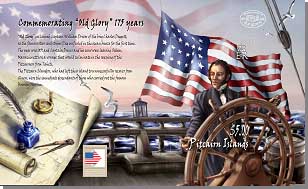The Charles Doggett Postage Stamp
 Around 1825 the population of Pitcairn had risen to 66 from 35 some 17 years earlier. John Adams, the leader of the community was concerned about the dwindling food, water and timber supply. He sought permission from Britain to move the population to Australia and this was granted in 1831 even though Adams had died in 1829 and the welfare of the inhabitants had improved.
Around 1825 the population of Pitcairn had risen to 66 from 35 some 17 years earlier. John Adams, the leader of the community was concerned about the dwindling food, water and timber supply. He sought permission from Britain to move the population to Australia and this was granted in 1831 even though Adams had died in 1829 and the welfare of the inhabitants had improved.
On 28 February 1831 the HMS Comet and the Colonial Barque Lucy Anne arrived to remove the Pitcairners, not to Australia but to Tahiti. The Islanders reluctantly left, arriving in Tahiti on 21 March. They were kindly treated by Queen Pomare IV and her people but the new arrivals did not feel at home or adjust to this different way of life. They longed to return to their own island, especially when infectious diseases, to which they had little immunity, began to kill them. Within two months 12 people had died and the plight of the Pitcairners became worse when attempts to return failed.
Captain William Driver captained the brig Charles Doggett and was based in Salem, Massachusetts. In 1831 he was departing Salem on one of his many world voyages when friends presented him with a flag bearing 24 stars. As his ship met the open sea, the ocean breeze unfurled the famous stars and stripes for the first time. “Old Glory” exclaimed Driver and history was created.
This particular voyage took the Charles Doggett to Tahiti where he was able to offer the Pitcairn Islanders passage for $500, which was gratefully accepted. The funds, raised by selling blankets and other necessities, enabled the community to board the brig and set sail from Papeete on 14 August 1831, reaching Pitcairn on 3 September.
Featured On These Websites:


